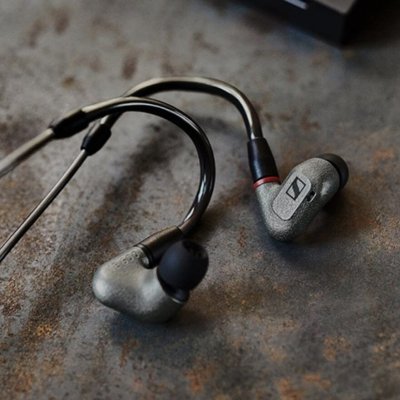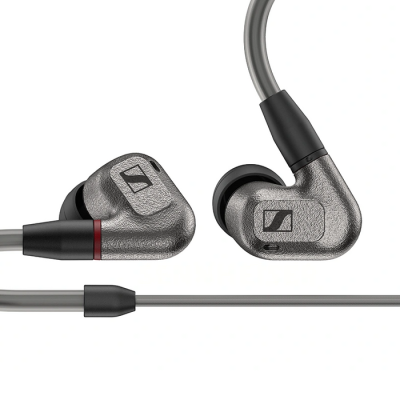Sennheiser IE600 and Yu9 Que use 1DD and 1DD+3BA driver setups respectively. Sennheiser IE600 costs $700 while Yu9 Que costs $409. Sennheiser IE600 is $291 more expensive. Yu9 Que holds a clear 0.7-point edge in reviewer scores (7.5 vs 8.1). Yu9 Que carries a user score of 8.5. Yu9 Que has better bass with a 0.9-point edge, Yu9 Que has significantly better mids with a 1.8-point edge, Yu9 Que has significantly better treble with a 1.6-point edge, Yu9 Que has significantly better dynamics with a 1.3-point edge, Yu9 Que has better soundstage with a 0.8-point edge, Yu9 Que has better details with a 0.8-point edge and Yu9 Que has significantly better imaging with a 1.4-point edge.
Insights
| Metric | Sennheiser IE600 | Yu9 Que |
|---|---|---|
| Bass | 7.3 | 8.2 |
| Mids | 6.5 | 8.3 |
| Treble | 6.4 | 8 |
| Details | 7 | 7.8 |
| Soundstage | 7.3 | 8.1 |
| Imaging | 6.5 | 7.9 |
| Dynamics | 6.5 | 7.8 |
| Tonality | 6.9 | 8.3 |
| Technicalities | 7.3 | 8 |
Sennheiser IE600 Aggregated Review Score
Average Reviewer Scores
Average Reviewer Score:
7.5Generally Favorable
Yu9 Que Aggregated Review Score
Average Reviewer Scores
Average Reviewer Score:
8.1Very Positive
Reviews Comparison
Sennheiser IE600 reviewed by Audionotions
Buy Sennheiser IE600 on HiFiGO
Ad
Price: $699
Buy Sennheiser IE600 on HiFiGO
Yu9 Que reviewed by Audionotions
Sennheiser IE600 reviewed by Jays Audio
Jays Audio Youtube Channel
Yu9 Que reviewed by Jays Audio
Youtube Video Summary
YU9 Que presents a balanced, almost neutral tuning with a tasteful touch of mid-bass for warmth and punch. Treble is clean and controlled—more clarity than “sizzle”—so detail comes through without harshness, while mids keep vocals natural rather than forward or thin. Technical performance sits in the “solid for the price” camp: separation and imaging are tidy, but not the kind of hyper-etched sparkle that chases wow factor.
In practice, it shines with slower pop, R&B, acoustic and vocal-centric tracks where its coherence and smoothness pay off; those seeking big sub-bass drama or ultra-aerated treble fireworks may find it a touch polite. Versus brighter, more contrasty sets, the Que trades spectacle for musicality and long-session comfort, making value hinge on whether a refined, low-fatigue signature is preferred over maximum excitement at the price point.
Jays Audio Youtube Channel
Sennheiser IE600 reviewed by Gizaudio Axel
Gizaudio Axel original ranking
Gizaudio Axel Youtube ChannelYu9 Que reviewed by Gizaudio Axel
Youtube Video Summary
Build & accessories: a hybrid 1DD + 3BA set priced around $399 with a spacious zipper case, multiple silicone tips, pouches, cleaning cloth, and shirt clip. The faceplate’s wavy, stone-like texture looks premium, and the shells use a 2-pin connector. The downside is the stock cable: it’s springy, only in 4.4 mm, and feels below the tier. Fit is serviceable but not ideal—the shell isn’t the most ergonomic, the nozzle lacks a lip, and seating a deeper fit can take a moment; once set, stability is good and tips stayed secure in use.
Sound: this isn’t a “new-meta” curve; it’s a unique, lively tuning. Bass is punchy, dynamic, and highly textured—more physical in practice than the graph suggests, with excellent impact and kick-drum authority. An early rise after 1 kHz pushes vocals front and center for an intimate, engaging presentation without tipping into shout. Treble is refined, sparkly, and well-extended: it is a bright set but avoids harshness, peakiness, sibilance, and fatigue, delivering crisp cymbals and defined transients even for rock and metal at any volume. Technicalities are class-leading under $500 with standout detail retrieval and separation; the one wish is a larger soundstage.
Comparisons & verdict: the Elysian Apostle still wins on bass texture/impact, treble refinement, and overall resolution, but the Yu9 Que offers a convincing “Apostle flavor” at a lower price. Versus Elysian Pilgrim, the Que is fuller and bassier, while Pilgrim’s treble is tamer; versus Volume S, the Que is cleaner, brighter, more detailed as the Volume S trends warmer with more neutral treble; against Dusk DSP, Dusk sounds more natural/balanced but the Que feels more fun and technical. Recommended for those who crave clarity, sparkle, and engagement without fatigue; less ideal if treble-sensitive or preferring a warm, relaxed tonality, and worth demoing for comfort. A top contender and serious gatekeeper around $400—final rating: 4.5/5 with a strong recommendation.
Gizaudio Axel original ranking
Gizaudio Axel Youtube ChannelSennheiser IE600 reviewed by Jaytiss
Yu9 Que reviewed by Jaytiss
Youtube Video Summary
The YU9 Que sports a premium, durable resin shell in pure black with a metallic-feeling faceplate and a comfortable design featuring an anti-tragus catch. While the build itself feels handsome and unique, the included cable is criticized as wimpy and unpleasant, with a strong suggestion to upgrade it. Accessories are deemed solid, including a nice selection of tips and a particularly praised case with a soft, luxurious interior.
Sonically, the YU9 Que earns immense praise for its exceptional tuning, described as clean, resolute, and non-fatiguing. It delivers strong, textured bass that avoids being overwhelming, coupled with extremely well-done upper mids. While not class-leading in technicalities like micro-detail or instrument separation, its tonal balance is considered sophisticated and reminiscent of far more expensive sets like the Annihilator, even surpassing the Monarch MKII in tuning preference. It's highlighted as a fantastic all-rounder with a smooth, agreeable signature suitable for long listening sessions.
Despite its modest single dynamic driver + 3BA configuration and $409 price point, the YU9 Que is declared a very special and unique IEM, worthy of the hype it received. The review concludes it's a price leader and a highly competent package from a small brand, offering outstanding value and a beautiful, well-executed design that makes it an easy recommendation for those seeking a smooth, non-fatiguing sound.
Jaytiss Youtube Channel
Sennheiser IE600 reviewed by Precogvision
Precogvision Youtube Channel
Yu9 Que reviewed by Precogvision
Youtube Video Summary
Yu9’s Que lands as a “safer Annihilator”: a warmer, scaled-back take that pushes ample sub-bass while keeping the rest tastefully controlled. The low end feels liquidy and bouncy, underpinning an aggressive 1–3 kHz rise with a gentle 3–5 kHz taper, so vocals sit upfront and crisp yet remain remarkably smooth thanks to the extra low-end warmth. Treble is slightly scooped around 5–6 kHz and then climbs in small, well-placed peaks out to ~15–18 kHz, yielding excellent extension that feels on par with sets like Moondrop Variations in this range.
What makes it pop is the value proposition: at $400, the overall resolution, tonal balance, and staging read far pricier—more like the $700–800 bracket. With its engaging sub-bass lift, lucid mids, and airy yet controlled top end, Que comes off as a polished, crowd-friendly tuning that still excites detail chasers. If momentum holds, this looks like the next big thing around the $400 mark.
Precogvision Youtube Channel
Sennheiser IE600 reviewed by Head-Fi.org
Yu9 Que reviewed by Head-Fi.org
Sennheiser IE600 (more reviews)
Sennheiser IE600 reviewed by Super* Review
Youtube Video Summary
$700 buys a compact, 3D-printed metal single-DD that looks mature and fits like a glove. The IE 600 arrives with two cables (3.5mm and 4.4mm) that are thin and comfy but a bit microphonic thanks to stiff, moldable ear hooks. Connectivity is MMCX, yet Sennheiser’s slightly non-standard recess limits third-party cable options. Isolation is a touch below average, but the tiny shells seat past the tragus, stay secure, and even work as a sleeping IEM. The real facepalm is the stock tips—especially the silicone set with collapsing walls. Foam tips are usable (and subtly affect treble), but the easiest fix is Final E-type tips, which keep the incisiveness while curbing sibilance better than Moondrop Spring Tips.
Tonally, think tasteful V-shape: a sub-bass-weighted low end with just enough mid-bass wallop for body, natural and appropriately forward mids, and spicy, well-extended treble. The draw is the technical ride—top-to-bottom texture, punch, and an almost visceral snap. Bass is a standout: deep, delineated rumble that doesn’t smear the mids yet feels physical on everything from EDM to Fleetwood Mac. Treble gives cymbals real weight and timbre (a spot where many sets thin out), while stage is bigger than average with solid imaging—cohesive rather than gimmicky holography. Compared side-by-side, it’s bolder and more contrasty than a warm-neutral Zen Pro, and far more physical than the airy, sterile-leaning Moondrop S8, yet it keeps vocals clean and convincing.
Quibbles exist—awful stock tips, a touch of treble bite depending on fit, and that picky MMCX—but the core experience is special. With a quick tip swap, IE 600 delivers endgame-within-reach performance: exhilarating bass quality, incisive treble, natural mids, comfort for hours, and virtually no deal-breaking caveats. At $700 it’s not cheap, but it competes fearlessly with far pricier IEMs and feels like a set to buy once and be done.
Super* Review original ranking
Super* Review Youtube ChannelSennheiser IE600 reviewed by Crin
Youtube Video Summary
Sennheiser’s IE600 reads like a course correction for a storied brand whose IEMs long suffered a 2–5 kHz dip and blunted energy. Here the midrange is finally set straight—no weird upper-mid recession, just natural, well-placed mids with proper presence. The single dynamic driver is tuned with uncommon discipline: a sub-bass-focused shelf that brings power and tactility without bleed, staying tight and controlled where past models went mushy.
The twist is the treble: an emphasis around 9–10 kHz that can split listeners. For some, that edge will read as sibilant; for others, it’s the rare, airy sparkle that makes cymbals and transients feel alive—call it the “blue cheese” effect. Technical chops are no afterthought either; resolution sits shoulder-to-shoulder with the IE900, trading blows with heavy hitters like Softears Turii, Dunu Luna, and JVC HA-FW10000, while avoiding their tuning quirks.
Measured against its field, the IE600 delivers A+ tone, A+ technical performance, and at $700 earns serious value credentials—enough to make the pricier IE900 feel hard to justify. In the wake of the Sonova acquisition, this feels like redemption: a market-breaking Sennheiser IEM that gets the fundamentals right, then adds just enough treble audacity to be special.
Crin Youtube Channel
Sennheiser IE600 reviewed by Tim Tuned
Youtube Video Summary
Sennheiser IE600 hits with a confidently V-shaped signature: powerful yet tidy bass that thumps with dynamic-driver slam, a flat, clean lower midrange, and lively upper mids that make vocals and instruments pop. Timbre is notably natural—free from plasticky glare—and the treble pushes plenty of sparkle and micro-nuance without tipping into sibilance or fatigue for most listeners. The result is an energetic yet slightly analytical listen, where details jump out, separation stays intact, and the stage opens up with convincing width and a sense of air. Imaging shows near-pinpoint placement with real depth, contributing to a presentation that feels both exciting and controlled.
In A/Bs, IE600 trades blows with mid-fi favorites: versus Moondrop Variations, the Sennheiser is the more resolving and a touch more natural in timbre (Variations projects a wider stage and leans cleaner/U-shaped). Against DUNU SA6, SA6 offers the safer, more reference-leaning tuning, but IE600 pulls ahead on detail, note definition, and stage size. Compared with Thieaudio Oracle, Oracle stays truer-neutral, yet IE600 flexes stronger technical performance—the kind usually reserved for pricier sets, rivaling classics like Clairvoyance and Monarch Mk1. The catch is treble quantity: those sensitive to extra top-end bite may find it a bit much. Everyone else gets a compact, feather-light shell with outstanding comfort, a richly textured low end, vivid mids, and class-leading detail under $1,000—an easy recommendation if an energetic treble tilt fits the taste.
Tim Tuned Youtube Channel
Sennheiser IE600 reviewed by Shuwa-T
Sennheiser IE600 reviewed by Nymz
Yu9 Que (more reviews)
Yu9 Que reviewed by Paul Wasabii
Youtube Video Summary
At ~$400, YU9 Audio Que sets a new bar for the bracket: a 1DD+3BA hybrid with a modest bass shelf, slightly forward mids, and linear treble extension that sounds more speaker-like than typical IEMs. The presentation is exceptionally polished and quiet-backgrounded, yielding crisp separation, convincing imaging, and staging in depth, width, and height that resembles far pricier gear.
The low end brings tactile mid-bass impact with deep, controlled sub-bass, pairing naturally with that extended, peak-free top end; the result is a true playlist killer across EDM, rock, vocal, and classical. Nitpicks exist: mids can sit a touch forward depending on track and the set rewards a slightly higher volume and a secure, deeper fit, while V-shape fans may find it too boring.
Compared with favorites like Dusk, Cadenza 4, and Volume S, Que keeps their strengths but fixes common complaints by delivering fuller bass weight, cleaner openness, and more realistic attack and dynamics. It does not need giant-killer claims to stand out; at this price it is simply class-leading.
Paul Wasabii Youtube Channel
Yu9 Que reviewed by Fox Told Me So
Tuning is clean, neutral, and slightly V-shaped: bass is tight, bouncy, and textured; mids sit slightly forward thanks to extra 700 Hz–2 kHz gain, giving vocals a bigger image; treble leans bright with a 4–5 kHz push for clarity, rolling off naturally rather than chasing EST-style air. Sibilance can appear (on “th” or “tsu”), but not harsh.
Stage favors width over depth—impressively wide at the price, with neat, well-ordered placement and strong separation. Resolution is crisp, background clean, every note clearly etched.
Fox Told Me So original ranking
Fox Told Me So Youtube ChannelYu9 Que reviewed by Kois Archive
Youtube Video Summary
Yu9 Que arrives with a surprisingly premium unboxing: a crush-resistant carrying case with plush padding, an IEM pouch, microfiber cloth, cable clip, and two ear-tip sets (standard silicone and more premium liquid silicone). A quirky 3D-printed nameplate with serial number and a faceplate etched in a topographic-map motif give it character. The shell is on the larger, wider side—comfortable for many, but small ears should test fit first. The stock cable is just okay (some memory, no chin slider), though it’s offered in 3.5 mm or 4.4 mm terminations.
Tonally, this is a neutral-reference set with a tasteful bass lift—clean impact without throwing off balance. Sub-bass has satisfying thump and texture, though bass-heads coming from sets like Kiwi Ears Punch may find it polite. The mids sit even and accurate—no “vocal magic,” yet clearly above average. Treble stretches well into the air with a touch of brightness that adds crispness and a slightly clinical edge, staying shy of fatiguing. Technical chops are the draw: a decently wide soundstage (roughly 3–4/5 by comparison), standout 3D imaging, and strong resolution/separation make it excellent for gaming—worthy of a two-controller nod—though ultimate detail still trails pricier kilobuck options.
Versus peers: Moondrop Dusk (DSP) is warmer with bass that hits a bit harder, while Yu9 Que is the more neutral, reference-leaning take. Elysian Pilgrim offers smoother treble, but Yu9 Que counters with better bass grip, stage, and imaging. AFUL Performer 7 tilts mild V; choose it for extra mid-bass and forward treble, otherwise Yu9 Que wins on technicality. Mega 5 EST chases the meta target yet stumbles in bass/treble; NiceHCK Rockies refines that approach and might be the more exciting alternative if spending slightly more. Bottom line: the hype is justified—a superb all-rounder around $400 with only the cable begging for an upgrade. It’s a clear pick for neutral/reference fans, though those seeking more “fun” might look elsewhere; call it a pragmatic, two-star recommendation amid a crowded market and likely pre-order waits.
Kois Archive Youtube Channel
Yu9 Que reviewed by Web Search
The YU9 Que is a hybrid IEM using 1 dynamic driver + 3 balanced armatures, positioned in the mid-upper price tier with an MSRP around $399. Retail listings confirm the configuration (10 mm LF DD with three Knowles BA units) and current pricing in USD and MYR, placing it among competitors that emphasize tonal refinement over sheer technical fireworks.
Community impressions describe a balanced/neutral tonality with a tasteful bass lift, smooth upper-mids that avoid glare, and treble that leans non-sibilant. Subjective reports on Head-Fi and Reddit consistently frame the Que as an all-rounder that favors coherence and long-term listenability over maximum micro-detail.
Technically, listeners note solid imaging and macrodynamics with competent detail retrieval, though not class-leading for the price. The manufacturer has also published frequency-response plots (IEC711 and BK5128 rigs), which aligns with the community’s take that the Que targets a broadly neutral/balanced signature rather than an aggressive V-shape. Overall value is credible at its MSRP if you prioritize tonal balance and comfort over ultra-analytical presentation.
Sennheiser IE600 Details
Driver Configuration: 1DD
Tuning Type: V-Shaped
Brand: Sennheiser Top Sennheiser IEMs
Price (Msrp): $700
Support our free service! Buying through our affiliate links costs you nothing extra:
Yu9 Que Details
Driver Configuration: 1DD+3BA
Tuning Type: Neutral with Bass Boost
Brand: Yu9 Top Yu9 IEMs
Price (Msrp): $409
Support our free service! Buying through our affiliate links costs you nothing extra:
Sennheiser IE600 User Review Score
Average User Scores
Average User Score: n/a
Based on 0 user reviews
No user reviews yet. Be the first one who writes a review!
Yu9 Que User Review Score
Average User Scores
Average User Score:
Based on 1 user reviews
8.5Excellent
Sennheiser IE600 Gaming Score

Gaming Score & Grade
- The gaming score is prioritizing technical capabilities of the IEM (Separation, Layering, Soundstage) and good value.
Gaming Score
6.7Gaming Grade
B+Yu9 Que Gaming Score

Gaming Score & Grade
- The gaming score is prioritizing technical capabilities of the IEM (Separation, Layering, Soundstage) and good value.
Gaming Score
7.9Gaming Grade
ASennheiser IE600 Scorings
Average Technical & Tuning Grades
Average Tunign Grade
B+- The tuning leans easygoing, yet occasional unevenness nudges it away from greatness. A bit of EQ polish can smooth things nicely.
Average Technical Grade
A-- It manages detail and layering well enough, even if the stage feels only moderately sized. You get a clear sense of left and right, if not depth.
Yu9 Que Scorings
Average Technical & Tuning Grades
Average Tunign Grade
A+- Tuning feels refined, blending frequencies with convincing realism and engagement. Transitions between registers feel effortless.
Average Technical Grade
A+- You get an articulate, polished performance with immersive stage depth and great control. There's a sense of polish across the whole spectrum.
Sennheiser IE600 User Reviews
"This is an example review"
Pros
- Example pro 1
- Example pro 2
Cons
- Example con 1
- Example con 2
Share your experience and build your personal ranking list.
You need to be signed in to write your own reviewYu9 Que User Reviews
Share your experience and build your personal ranking list.
You need to be signed in to write your own reviewTastefully tuned IEM. It gives some unique colorations to the sound, making vocals sound pretty crisp and clean but in a tasteful way. Add a very satisfying amount of bass (including mid-bass!). Treble is top-notch.
Pros
Tuning, especially bass and treble. But mids do not disappoint as well.Cons
I wouldn't describe this as neutral or even reference sounding. Soundstage could be wider.Find your next IEM:
IEM Finder Quiz
newIEM Comparison Tool
newVS






























